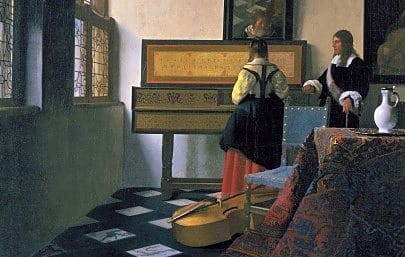December 8, 2014

Father Frank Sabatté, CSP
When I was a Paulist student, a very wise Paulist priest, Father Ben Hunt, preached on Matthew 5:14: “You are the light of the world.”
“When you step into a well lit room at night, unless it’s coming from a particularly beautiful lamp, you normally do not notice the source of light. Yet you are able to walk around the room and not trip over furniture because of that light. When Jesus says, ‘You are the light of the world,’ he means that his followers are to be a light for others, but don’t expect to be recognized. It is enough to know that your light is helping others to see.”
Tim Jenison wanted to paint a Vermeer. He was an engineer, not an artist, and was convinced that Vermeer used an optical system to capture the images with photographic realism. So he set out to prove it. As a wealthy software developer he had unlimited funds and so spent thousands of dollars and over a year to recreate the setting of Vermeer’s painting “The Music Lesson.” (View a very detailed version of the original Vermeer at the Google Cultural Institute or download a photo [6 MB].)
Using an optical device based on his research, he painted his Vermeer. He painted every tiny detail including the dots that made up the weave of the carpet. More than a year later he finally finished the painting.
It was impressive, but something was missing.
None of the reviews I read mentioned anything about it, but it was quite obvious to me. The faces, hands and bare arms of the figures, the man and woman, in Tim’s Vermeer lacked any kind of translucence, the kind of glow that you see in the figures of a genuine Vermeer and in any of he great old masters. In other words, Tim copied the surface of the figures but did not know how to manipulate light so that their skin had depth. They looked more like “paint by number” figures than live persons. Tim had no understanding of under painting, or grisaille or glazing, and it showed. The old masters knew how to control light as it hits the canvas. A monochrome under painting (often in grays, thus “grisaille”) provides the base for subsequent layers of colored glazes. The light penetrates the glazes, hits the under painting and is reflected back thus creating the illusion of translucent skin. In other words, Vermeer, who was a master artist, knew that what mattered in his painting was what you don’t see. You will never see the under painting, but it is there reflecting the light and causing you to stand in awe before these figures who appear very much alive.
The light of Christ is the only way any of us can see our way to do justice, to bring mercy and to desire the good of another, which is to love, but we seldom, if ever, notice the light source. Advent is the time to realize that what matters, what has always mattered is what we don’t see which is, nevertheless, the only way we see at all.
